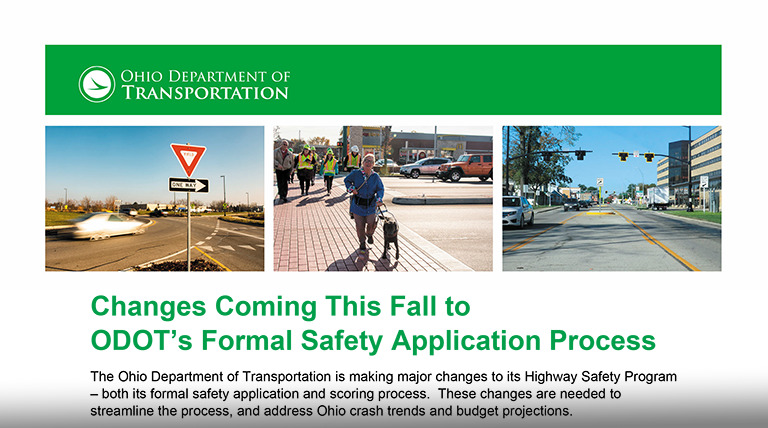
In Fall 2021, Ohio Department of Transportation (ODOT) adjusted its Highway Safety Improvement Program (HSIP) process to include with equity components in scoring. Their HSIP process now integrates crash data with correlated U.S. Census data.
Based on ODOT research, in Ohio, fatal and serious injury crashes are overrepresented by 9.8% within Census block groups that have a poverty rate (population with income below the poverty line) at or above 10%. They found that economic distress (poverty) has a direct correlation with severe crashes in Ohio, so they have adjusted their HSIP program to address these areas.
Willing to Try
To ODOT’s knowledge, there was no handbook for equity and HSIP funding. But they had experience with active transportation, Safe Routes to School, and the Walk-Bike Ohio Study, so as a Department they had been looking at equity measures for a long time. For example, equity was the first goal established for the Walk-Bike study:
Ensure the system accommodates users of all ages, abilities and incomes. Provide opportunities for all Ohioans in urban, suburban and rural areas to have access to connected walkways and bikeways.
Through the study, ODOT found that 35% of Ohio residents lived in high need areas with “high rates of poverty, high mortality rates, limited English proficiency, limited access to motor vehicles and beyond.” Performance targets were set to prioritize funding in high need, high demand areas. Partnerships were sought with organizations that could help ODOT with its equity goals, and action items included developing project selection and monitoring criteria related to equity.
“Our attitude has always been, we’re not afraid to try things, and make adjustments as we implement,” says Michelle May, manager of ODOT’s Highway Safety Program, speaking on moving forward without formal guidance.
ODOT discussed the opportunity with metropolitan planning organizations, Vision Zero cities, and the DOT’s district safety teams. These stakeholders were extensively involved in helping develop new scoring for HSIP funds for local safety projects to include equity metrics.
ODOT's Equity Metric
ODOT’s equity metric applies American Community Survey data from the Census Bureau’s 2019 and the 2010 Census records (which they’ll update when 2020 Census data is released). ODOT has a long history of looking at economic factors in other programs (such as adding capacity). The DOT’s planning group, in particular, uses Census data frequently, so this was a familiar source for the Department, their leadership, and stakeholders.
ODOT reviewed crash data in Census block areas alongside poverty and race metrics. The poverty metric stood out in the comparisons—there was an overrepresentation of crashes in low-income areas. People in communities with 10% or more residents living at poverty level experienced at least 10% more traffic fatalities and serious injuries, compared to Census block groups with lower poverty rates. Looking at the poverty metric and pedestrian crashes, there were twice as many pedestrian fatalities and serious injuries in low-income communities than in communities with average or higher incomes.
After finding the correlation between economic measures and crash data, and with extensive stakeholder involvement, ODOT developed equity metrics to apply to safety project prioritization.
ODOT’s project selection process allocates 10% of their scoring to economic performance factors based on poverty and employment data. The scoring considers current economic distress, as well as the potential for economic growth.
Safety projects in a Census block group with a poverty rate below 10% receive a score of zero. Projects within block groups with poverty rates above that level receive incremental scores up to 10, based on average poverty rates.
Safety is still the major factor in prioritizing HSIP funds. Crash hot spots for fatalities and serious injuries are the starting point to qualify for funding, and equity metrics are now added in.
Applying Equity to the Local Matching Funds
Using economic distress metrics, as well as other information provided by funding applications, ODOT is able, in some cases, to reduce the required local match. For example, cities may be eligible for a reduced local match if they have 10% or more of the community living at poverty levels, based on U.S. Census/American Community Survey data.
The Ohio State Auditor releases a list of communities in fiscal distress each year. These communities are eligible for an automatic reduction or elimination of local match requirements. Revenue credits and state funding are used to reduce the match. Poverty metrics in project location areas may also reduce match requirements.
Helping Communities with Limited Resources to Apply
In addition to adjusting project scoring, ODOT is addressing the barriers that keep low-income communities from participating in the HSIP process. Historically, ODOT received many local funding applications from communities with more resources. Economically disadvantaged communities didn’t have the resources to justify funding requests. ODOT wanted to help Ohio communities with fewer financial resources struggling to make critical safety investments. Many communities have historically lacked the resources to apply for safety funding or provide the required local match. To expand their opportunities to participate in the program, ODOT is now providing free safety study assistance, to help communities with higher economic barriers to entry in the HSIP process.
Early Successes and Plans to Move Forward
As of Fall 2021, ODOT finished a formal round of funding higher-dollar spot location projects. The formal round takes place each fall. In early 2022, ODOT will also accept and consider applications for systemic projects, specifically roadway departure or pedestrian projects. Both processes will use equity metrics in the scoring and decision making.
So far, the types of spot location projects ODOT is funding include roundabouts, flashing yellow arrows, road diets for arterials, and rural fixes like a turbo lane and a restricted crossing U-turn (R-cut). They’ve already noticed that some local governments are rethinking the projects they’re proposing for HSIP funds, based on the new severity and equity scoring metrics.
ODOT district safety teams have expressed that they appreciate the effort to correlate equity factors with traditional crash data. As new American Community Survey data becomes available, ODOT plans to compare additional socioeconomic and sociodemographic metrics to crash data, to expand and improve on current methodology. Some types of data they may analyze alongside crash data include race and ethnicity, English proficiency, and education levels in Census block areas.
The State of Ohio has an established statewide equity committee that ODOT participates in. The Department has also developed an internal social equitability task force, to keep moving forward in equity in transportation.
Contact Information
If you found this case study inspiring or have questions about ODOT’s approach, reach out to Jeremy Thompson, safety engineer, ODOT Highway Safety Program, Jeremy.Thompson@dot.ohio.gov, or (614) 466-7045.

